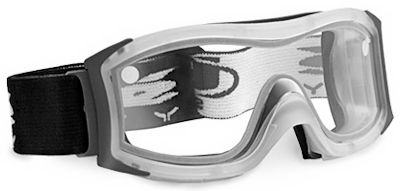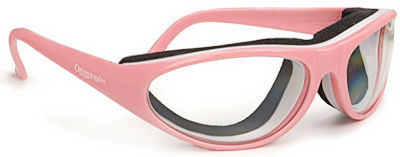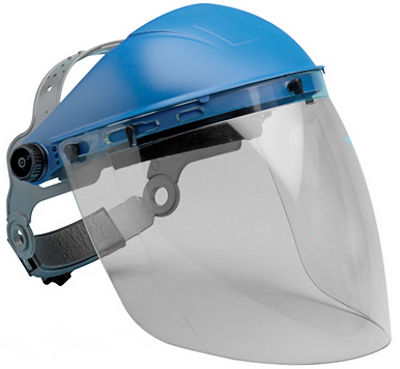The right eye protection can save your eyes from being injured by lye and soap splashes during soap making and from hazardous or irritating dusts used in soap and other bath and body (B&B) products. Here is my guide for choosing the best eye gear for making soap and other bath and body products.
Safety glasses protect against direct impact...
...but they are not designed to protect your eyes from chemicals dripping down your head or spraying up from below. They also do not protect agains hazardous or irritating dusts and mists.
While wearing safety glasses for soaping is better than wearing nothing at all, safety glasses (and regular eye glasses) are not the best choice for making soap and other B&B products.
If you do buy safety glasses, they are available in prescription or non-prescription versions and can have clear or tinted lenses. Regardless of the style, look for safety glasses that are ANSI Z87.1-2010 certified (USA) or CSA Z94.3 certified (Canada), so you know they have been tested to effectively protect your eyes. This certification stamp will be permanently marked on the frame of the glasses.

Chemical splash goggles...
...do a much better job than safety glasses for protecting your eyes from hazardous liquid chemicals and hazardous or irritating dusts. As with safety glasses, look for goggles that are ANSI Z87.1-2010 certified (USA) or CSA Z94.3 certified (Canada).
Chemical goggles can have open vents or indirect vents to allow moisture to escape or no vents at all. Look for chemical splash goggles with an indirect vent design to prevent splashes and spray from entering into the goggles, something that can happen with an open vent design. Ventless types fog very easily, so I cannot recommend them.
Fogging is a big problem, especially with cheap ventless goggles, so spend a bit more for goggles that have indirect vents, double lens, and anti fog coating. My double-lens Bolle goggles (below) fog a lot less than the Uvex single-lens goggles I also use. The ultimate defense against fogging is a battery operated fan system. Some models of Haber goggles have a tiny fan that turns on and off as the humidity varies inside the goggles.
If you wear glasses, look goggles designed to fit over prescription glasses or goggles with bifocal corrections built into the lens for reading. If your face is small, look for goggles with a narrower, smaller frame designed for women.

"Onion goggles"...
...are intended to protect the eyes from irritating fumes created when cutting onions. They are also used by many people for soaping. Onion goggles fit more closely around the eye socket with a narrow foam seal not designed to stop liquids from leaking inside the goggles. Chemical splash goggles cover a wider area of the face -- around the upper cheek, eyebrow, and temple area -- and have a wider seal designed to be liquid tight.
Onion goggles are better than no eye protection at all, but be warned they will not protect your eyes as well as chemical splash goggles. Onion goggles are not tested to ANSI or CSA specifications -- they are only meant to keep a person from crying when cutting up onions, not for serious protection against chemical splashes. I do not recommend them for soaping.

A face shield is a good alternative to chemical splash goggles...
...for protection from chemical splashes and spray. Again, be sure to look for face shields that are ANSI Z87.1-2010 certified (USA) or CSA Z94.3 certified (Canada).
A face shield consists of two parts that may come as a kit or may be sold separately. The first part is the head gear that fits on your head like a cap. The head gear has various adjustments to allow it to fit snugly and comfortably. The second part is the replaceable shield that covers the face. The shield can be clear or tinted and comes in a variety of shapes. The shield fastens onto the head gear to form a complete unit.
Unlike goggles, a face shield covers the entire face for complete face protection against splashes and spray. A face shield is also less likely to fog, but it is more bulky than goggles. A face shield will not be as effective against hazardous or irritating dusts, so if you need that kind of protection, consider chemical splash goggles or a full-face respirator.
Shields with a three-dimensional curved shape like the one shown below have less visual distortion when you look down and may be a bit more comfortable to wear. Some shields are cut a little narrower or shorter than standard to better fit smaller faces. Prescription glasses can be worn under any face shield with ease.

Notes
More about ANSI Z87.1-2010 testing and certification....
Safety glasses, goggles, and face shield images and all links above are from Safety Glasses USA, http://www.safetyglassesusa.com. I have no affiliation with nor have I received any compensation from this company. I am simply one of their satisfied customers.
Onion goggle image is from Cutlery and More, http://www.cutleryandmore.com
Copyright © 2002-2025 - All rights reserved by Classic Bells Ltd.
Template by OS-templates.com